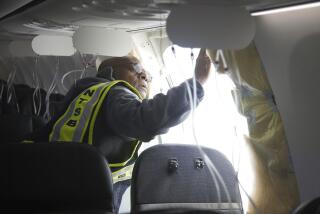Shots Unlikely to Down Plane, Experts Believe
- Share via
Aviation experts suggested Tuesday that it is unlikely a gunman could have caused the crash of PSA Flight 1771 unless he shot “two critical components”--the pilot and the first officer.
Emphasizing that they could speak only in the most hypothetical terms, these specialists said that simply firing bullets into an airplane’s fuselage should not make it crash. Airliners are generally built with enough engineering redundancy to continue to fly even if an engine or another sensitive system was crippled by a bullet after it had torn through the plane’s body, they noted.
“If you were going to deliberately come up with something that would withstand a small explosion you’d make it look a lot like an airplane,” said Richard H. Wood, a private aircraft accident investigator and director of the aviation safety program at USC.
“I’ve been thinking all day long about it and I can’t hypothesize any point on the plane you could hit and guarantee a catastrophic result,” he said. “Not to say it couldn’t happen from some phenomenal combination of circumstances.”
As evidence, Wood cited an April, 1986, incident in which a small bomb ripped out a section of a TWA jet in flight over Greece. While the blast blew a gaping hole in the plane’s side--through which four passengers fell to their deaths--the plane landed safely.
“You can hypothesize all kinds of weird things--perhaps a bullet went through the fuselage and into a wing fuel tank and ignited a fire--or you can pick an obvious one, in which the plane goes down because you shoot two critical components--the pilots,” Wood said. “I would tend to go with the (disabling of the) pilot.”
Roger Stuart, a PSA pilot and pilot trainer who flies the same type of British Aerospace plane, agreed.
“I can see where a bullet would cause a malfunction that would create an abnormal situation, but not to the point where it would completely disable an aircraft unless it was an explosion,” he said.
Ability to Survive
“On the (British Aerospace) 146, a bullet can take out the hydraulic system, the electrical system, the power plant, an engine can fail--and it will continue to fly; it has a redundant system,” he said.
The BAe 146 is a four-engine jet aircraft with wings mounted above the fuselage. It is flown by two people in the cockpit--a captain and a first officer.
Speculation among engineers and pilots about why Flight 1771 crashed, killing all 43 aboard, began flourishing late Monday with the first reports that the pilot had told air traffic controllers shortly before the crash that gunshots had been fired aboard the plane.
It increased Tuesday when the FBI said it believes the crash was caused by a “criminal act,” and news reports indicated that a disgruntled former employee of USAir had evaded Los Angeles International Airport security systems and taken a .44-caliber Magnum on board the flight in order to kill his ex-boss, a passenger on the flight.
Other scenarios put forth Tuesday involved a stray bullet penetrating a fuel tank in the wings, causing an explosion; a bullet entering one of the turbines and causing some of the fast-moving blades to break off, turning into shrapnel-like fragments that would disable an engine; or a bullet severing the wire connected to a critical control system.
Other Speculation
Also being discussed was whether the gunman might have carried aboard something more powerful--a hand grenade or other explosives.
However, experts said it was unlikely that the fuel tank would actually explode even if penetrated by a bullet. In addition, they said, it is difficult, although not impossible, to conceive of the plane crashing due to the disabling of one system.
“Stranger things have happened, but at first glance it doesn’t seem to have been just one bullet causing an airplane to crash,” said Wallace Fowler, a University of Texas aerospace engineering professor at Austin.
“The only thing I can see is that the crew had to lose control of the plane physically,” said PSA pilot Stuart, who said reports of the crash made him think about a similar incident in 1964 in which a passenger on a Reno-to-San Francisco flight took out a $100,000 insurance policy before the flight, then apparently shot at least one member of the crew, causing a crash that killed 44 people.
Engineer Not Pleased
James C. Williams III, chairman of the department of aerospace engineering at Auburn University in Alabama, said he found the immediate speculation distasteful.
“It disturbs me as an engineer because nothing is known,” he said. “Look at how long it takes the NTSB (National Transportation Safety Board, the federal agency responsible for investigation) to determine a cause.”
In this case, Wood of USC said, it will probably be difficult for NTSB investigators to trace the path of the bullets “and figure out what they could have hit other than the pilot.”
“On the other hand, the evidence of what the bullet did should be visible, because it is going to leave distinct puncture-type damage which obviously came from the inside out. Normal impacts don’t produce that kind of damage.”
More to Read
Sign up for Essential California
The most important California stories and recommendations in your inbox every morning.
You may occasionally receive promotional content from the Los Angeles Times.










